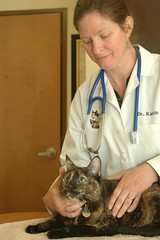In Veterinary Medicine, the Standard of Care is rarely standard

It’s often said that “the standard of care is a moving target,” and nowhere is that more true than in veterinary medicine. Over the last ten years, the level of care available to pets has skyrocketed. We’ve become more accepting of the need for pain management in pets, realized that we were probably vaccinating more than we need to, and recognized that good oral health is critical for good health in general. Specialists in surgery, cardiology, internal medicine, ophthalmology, dermatology, oncology, radiology and other fields have left the teaching hospitals and begun serving most large cities. There’s never been a time when we could provide such advanced medical care for our pets. But there’s also never been a time when the veterinary standard of care was up for so much debate, either.
Because while the health insurance industry and legal system have a strong hand in determining the standard of care for your two-legged family members, it’s still really up to each veterinarian to determine what theirs will be for the four-legged ones. Many things factor into that decision for each of us. Things like where we went to school and how long ago, how much time and money we invest in keeping up with developments in the field and learning new skills, and our personal beliefs about the importance of pets in general. We also have to consider how many clients want to provide that level of care for their pets, how much financial risk we’ll have to take on to provide it, and, of course, the standard of care for the profession as a whole.
At the moment, the standard of care—at least as it’s legally defined—for veterinary medicine doesn’t set the bar very high. Fortunately, vets like to do a good job, and most I’ve met practice somewhere above the “standard,” but there’s still a lot of variation from one vet to another. The hard part is that the variety isn’t just between different practices—sometimes it’s between individual veterinarians at the same practice! And it’s not unusual to find vets who have exceptionally high standards in one area of practice and at the same time seem to have standards left over from the 1970’s in others.
So, what’s a pet lover to do? How can you tell what your vet’s standard of care is? How do they choose their standard of care? Does it vary from doctor to doctor in their practice? Does their standard match the level of care you want to provide for your pet? If not, are they willing to discuss options that differ from their standard?
Put simply: Ask. They should be happy to answer.
Here are Priority Pet Hospital’s answers:
- Priority Pet Hospital is one of only three Gilbert veterinarians accredited by AAHA, the American Animal Hospital Association. We have voluntarily agreed to be evaluated against AAHA’s standards, every three years. These standards represent a set of 900 best practices that only about 15% of veterinary facilities in the US meet. Our commitment to the accreditation process lets you know that we’ve set the bar high for ourselves.
- AAHA’s standards are just the beginning. Next we ask: is this all we would do for our pets? If the answer is “no,” we raise the bar notch by notch until we can say “yes,” and AAHA’s standard becomes our minimum standard of care.
- Our team discusses our standards regularly, and we stay up-to-date using seminars, conferences, medical journals, and the Veterinary Information Network, an online community of colleagues. Our doctors have agreed to adhere to a consistent standard of care, so the recommendations you hear won’t change from doctor to doctor. And, finally, our standard of care is re-evaluated and updated from time to time to reflect changes in the science of medicine.
- Priority Pet Hospital is a natural fit for pet owners who want to know that their vet will make recommendations based on high standards. At the same time, we’re always willing to discuss options for care that lie between the minimum standard and the level of care we recommend. Only after pet owners understand the risks and benefits of the different options can they make the best decisions for their pets.
Now we ask: What standards do you use when choosing a veterinarian? Fill us in below!
Schedule an appointment with our veterinarians in Gilbert, AZ by calling or filling out our online form!

